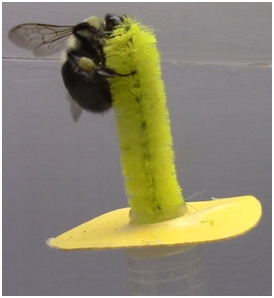Artificial pollen dispensing flowers and feeders for bee behaviour experiments
DOI:
https://doi.org/10.26786/1920-7603(2016)14Abstract
The study of foraging behaviour in plant-pollinator mutualisms has benefitted from the use of artificial flowers to manipulate floral display traits and the delivery of floral rewards. The two most common floral rewards are pollen and nectar; some pollinators, such as bees, are obliged to collect both for survival and reproduction. While flexible designs for artificial flowers providing nectar rewards abound, useful designs for artificial flowers that dispense pollen are few. This disparity mirrors a heavy emphasis on nectar collection in the study of pollinator foraging behaviour. In this study we describe a novel, easily constructed and modifiable artificial flower that dispenses flexible amounts of pollen via an ‘anther’ composed of a chenille stem. Using controlled lab assays, we show that more pulverized honeybee pollen is collected by bumblebee (Bombus impatiens) workers at chenille stem feeders than at dish-type feeders. We suggest that the paucity of studies examining pollinator cognition in the context of pollen rewards might be partly remedied if researchers had access to inexpensive and easily adjustable pollen-offering surrogate flowers.

Downloads
Published
How to Cite
Issue
Section
License
Copyright (c) 2016 Avery Leigh Russell, Daniel R Papaj

This work is licensed under a Creative Commons Attribution 4.0 International License.
JPE is an open access journal which means that all content is freely available without charge to the user or his/her institution.
Authors who publish with this journal agree to the following terms:
1) Authors retain copyright and grant the journal right of first publication with the work simultaneously licensed under a Creative Commons Attribution License that allows others to share the work with an acknowledgement of the work's authorship and initial publication in this journal.
2) Authors are able to enter into separate, additional contractual arrangements for the non-exclusive distribution of the journal's published version of the work (e.g., post it to an institutional repository or publish it in a book), with an acknowledgement of its initial publication in this journal.
3) Authors are permitted and encouraged to post their work online (e.g., in institutional repositories or on their website) prior to and during the submission process, as it can lead to productive exchanges, as well as earlier and greater citation of published work (See The Effect of Open Access).
To assure a broader targeted audience, content will be included into databases (such as EBSCO) and directories (such as DOAJ).











